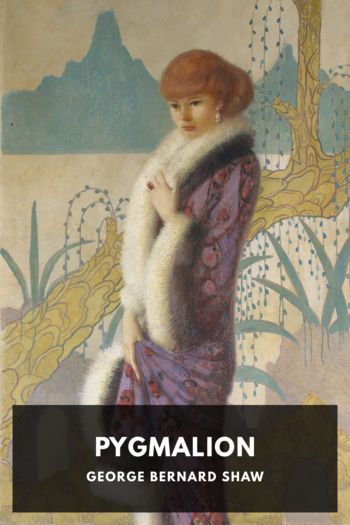Bulfinch’s Mythology Thomas Bulfinch (intellectual books to read TXT) 📖

- Author: Thomas Bulfinch
Book online «Bulfinch’s Mythology Thomas Bulfinch (intellectual books to read TXT) 📖». Author Thomas Bulfinch
“And so befell that after the thridde cours,
While that this king sat thus in his nobley,
Herking his minstralles thir thinges play,
Beforne him at his bord deliciously,
In at the halle door all sodenly
Ther came a knight upon a stede of bras,
And in his hond a brod mirrour of glas;
Upon his thombe he had of gold a ring,
And by his side a naked sword hanging;
And up he rideth to the highe bord.
In all the halle ne was ther spoke a word,
For mervaille of this knight; him to behold
Full besily they waiten, young and old.”
↩
The terms of admiration in which the older writers invariably speak of glass windows would be sufficient proof, if other evidence were wanting, how rare an article of luxury they were in the houses of our ancestors. They were first introduced in ecclesiastical architecture, to which they were for a long time confined. Glass is said not to have been employed in domestic architecture before the fourteenth century. ↩
Throughout the broad and varied region of romance it would be difficult to find a character of greater simplicity and truth than that of Enid, the daughter of Earl Ynywl. Conspicuous for her beauty and noble bearing, we are at a loss whether more to admire the patience with which she bore all the hardships she was destined to undergo or the constancy and affection which finally achieved the triumph she so richly deserved.
The character of Enid is admirably sustained through the whole tale; and as it is more natural, because less overstrained, so perhaps it is even more touching than that of Griselda, over which, however, Chaucer has thrown a charm that leads us to forget the improbability of her story. ↩
The Island of the Mighty is one of the many names bestowed upon Britain by the Welsh. ↩
Caractacus. ↩
Cassivellaunus. ↩
There is a Triad upon the story of the head buried under the White Tower of London, as a charm against invasion. Arthur, it seems, proudly disinterred the head, preferring to hold the island by his own strength alone. ↩
Creiddylad is no other than Shakespeare’s Cordelia, whose father, King Lear, is by the Welsh authorities called indiscriminately Llyr or Lludd. All the old chronicles give the story of her devotion to her aged parent, but none of them seem to have been aware that she is destined to remain with him till the day of doom, whilst Gwyn ap Nudd, the king of the fairies, and Gwythyr ap Greidiol, fight for her every first of May, and whichever of them may be fortunate enough to be the conqueror at that time will obtain her as a bride. ↩
The Welsh have a fable on the subject of the half-man, taken to be illustrative of the force of habit. In this allegory Arthur is supposed to be met by a sprite, who appears at first in a small and indistinct form, but who, on approaching nearer, increases in size, and, assuming the semblance of half a man, endeavors to provoke the king to wrestle. Despising his weakness, and considering that he should gain no credit by the encounter, Arthur refuses to do so, and delays the contest until at length the half-man (Habit) becomes so strong that it requires his utmost efforts to overcome him. ↩
The romancers dwell with great complacency on the fair hair and delicate complexion of their heroines. This taste continued for a long time, and to render the hair light was an object of education. Even when wigs came into fashion they were all flaxen. Such was the color of the hair of the Gauls and of their German conquerors. It required some centuries to reconcile their eyes to the swarthy beauties of their Spanish and Italian neighbors. ↩
Ivanhoe, Vol. 1, chap. XIII. ↩
It is plain that Shakespeare borrowed from this source the similar incident in his As You Like It. The names of characters in the play, Orlando, Oliver, Rowland indicate the same thing. ↩
See their story in “King Arthur and His Knights.” ↩
This is a poetical description of a phenomenon which is said to be really exhibited in the strait of Messina, between Sicily and Calabria. It is called Fata Morgana, or Mirage. ↩
This prophecy is introduced by Ariosto in this place to compliment the noble house of Este, the princes of his native state, the dukedom of Ferrara. ↩
ColophonBulfinch’s Mythology
was published in 1867 by
Thomas Bulfinch.
This ebook was produced for
Standard Ebooks
by
David Grigg,
and is based on a transcription produced in 2018 by
Marcia Brooks, Cindy Beyer, and The Online Distributed Proofreading Team
for
Project Gutenberg
and on digital scans available at the
Internet Archive.
The cover page is adapted from
The Lament for Icarus,
a painting completed in 1898 by
Herbert James Draper.
The cover and title pages feature the
League Spartan and Sorts Mill Goudy
typefaces created in 2014 and 2009 by
The League of Moveable Type.
The first edition of this ebook was released on
July 12, 2019, 9:12 p.m.
You can check for updates to this ebook, view its revision history, or download it for different ereading systems at
standardebooks.org/ebooks/thomas-bulfinch/bulfinchs-mythology.
The volunteer-driven Standard Ebooks project relies on readers like you to submit typos, corrections, and other improvements. Anyone can contribute at standardebooks.org.
UncopyrightMay you do good and not evil.
May you find forgiveness for yourself and forgive others.
May you share freely, never taking more than you give.
Copyright pages exist to tell you can’t do something. Unlike them, this Uncopyright page exists to tell you, among other things, that the writing and artwork in this ebook are believed to





Comments (0)